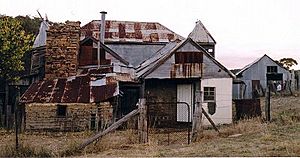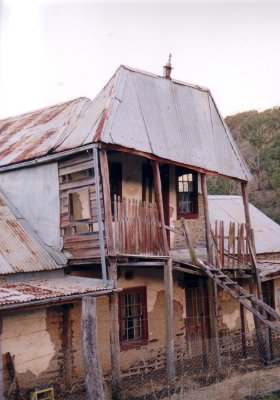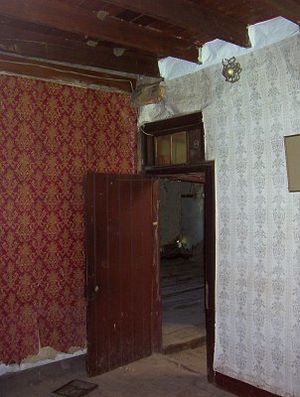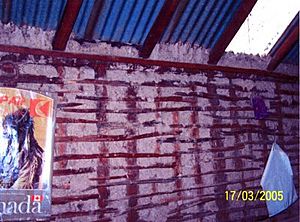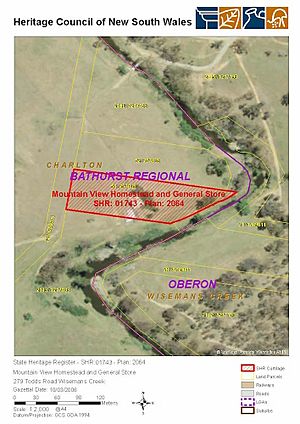Mountain View Homestead and General Store facts for kids
Quick facts for kids Mountain View Homestead |
|
|---|---|
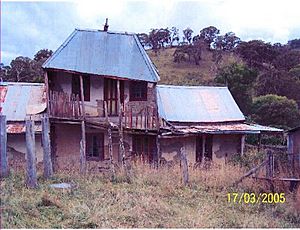
Mountain View Homestead and General Store, 2005
|
|
| Location | Wisemans Creek, Oberon Shire, New South Wales, Australia |
| Built | 1880–1894 |
| Architect | David Smith Todd |
| Official name: Mountain View Homestead and General Store | |
| Type | state heritage (built) |
| Designated | 10 March 2006 |
| Reference no. | 1743 |
| Type | House |
| Category | Residential buildings (private) |
| Builders | David Smith Todd |
| Lua error in Module:Location_map at line 420: attempt to index field 'wikibase' (a nil value). | |
The Mountain View Homestead and General Store is a special old house and shop located in Wisemans Creek, Australia. It's listed as a heritage site, meaning it's important to protect its history. A man named David Smith Todd designed and built this homestead between 1880 and 1894. It was added to the New South Wales State Heritage Register on March 10, 2006. This place tells us a lot about life in rural New South Wales over a hundred years ago.
Contents
History of the Mountain View Area
First People and Early European Settlers
Long before European settlers arrived, Aboriginal people lived in the Blue Mountains area. Evidence shows they were here at least 12,000 years ago. The Wiradjuri people were the traditional owners of the land around what is now Bathurst. They moved around in small groups, following food sources along the Macquarie River.
When Europeans first explored west of the Blue Mountains in 1813, they started settling the area. This led to big changes for the Aboriginal people. By the 1840s, their traditional way of life was greatly disrupted. The gold rush after 1850 made things even harder for them.
Lachlan Macquarie, who was the Governor of New South Wales, officially named Bathurst a town on May 7, 1815. He named it after Lord Bathurst. Bathurst is known as Australia's oldest inland town.
How Bathurst Town Grew
Governor Macquarie chose the spot for Bathurst in 1815. A road had already been built by convicts under the supervision of William Cox. Macquarie set aside land for government buildings. At first, he didn't want too many people settling in the rich Bathurst Plains.
One of the first land grants was given to William Lawson. He was one of the three explorers who crossed the Blue Mountains in 1813. In 1818, a small number of farms were given out. The town slowly started to grow.
By 1819, Bathurst had about 120 people living in 30 houses. Most of these were in Kelso, on the east side of the Macquarie River. The government farm, which was never very successful, was closed in 1828. The town's layout was later designed by Thomas Mitchell in 1830. The first land sales happened in 1831.
The Story of Mountain View Homestead
The Todd family, including David Smith Todd, moved to Wiseman's Creek in 1854. David's father, William Todd, was a farmer and ran a General Store. When David turned 21, he bought land a bit further up Stoney Creek. In 1865, David married Letitia Connelly. They built their first home, made of timber slabs, next to their General Store. This original home was later taken down in 1907.
During the gold rush in the 1870s and 1880s, David Todd leased parts of his land to Chinese and European miners. People said that as many as 400 people lived near the homestead during this busy time.
In the 1880s, David started building the Mountain View homestead. This two-storey building was made using a special technique called "wattle and daub." This means a frame of wooden poles (wattle) was filled in with a mix of mud and stone (daub). The materials came right from his own property. The house was finished in 1894, a date you can still see above the front door.
The homestead has fancy decorations and large rooms. This shows that David Todd was not just a farmer and shop owner. He was also a romantic and artistic man. He wrote poetry, painted, and gave public talks. He even ran for election in 1889.
The General Store started operating as early as 1868. It served local farmers and the many gold and silver miners in the area. The 1880s were the busiest years for mining. As mining slowed down in the 1890s, the General Store was later changed into a shearing shed for sheep.
The Mountain View property was very large. David Todd grazed sheep and had big orchards and wheat fields. The family also had a vegetable garden. This helped David, Letitia, and their seven children be quite self-sufficient.
David Todd passed away in 1929. His daughter, Alice Davina Gunning, inherited most of the property. Her son, Cecil Gunning, later inherited Mountain View. In 1973, he sold it to the McKinney family. Ross and Betty McKinney lived in the homestead with their two children from 1974. Betty Somerville (née McKinney) remembers it was a big change from city life. The house didn't have electricity at first. They used an old stove for cooking and a mangle for washing clothes.
Betty worked hard to make a living from farming. She also helped set up Camp Howard Country camps on the property. In the late 1980s, when the wool industry declined, Betty focused on tourism. She offered horse riding and was part of a Japanese Farm Stay Scheme in 1991.
In 2003, the Mountain View property was put up for sale. Half of it was sold, but Mrs. Betty Somerville still owns the half with the homestead. It is currently leased to Morris Lyda and his wife.
What Mountain View Looks Like
Mountain View is a two-storey house built using the "wattle and daub" method. On the ground floor, there are six rooms: four bedrooms, a lounge room, a kitchen, and a bakehouse. The kitchen has a large fireplace and a stone chimney. There are also two other decorative fireplaces with chimneys. One is in the lounge room and the other in a downstairs bedroom.
Upstairs, there are two large rooms: a bedroom and a rumpus room. To build the walls, wooden poles were placed about 40 to 60 cm apart. Then, thin strips of wood (lath) were nailed across them. The spaces were filled with mud and stone. The timber came from the property, and the mud was dug from a nearby gully.
The outside walls were covered with lime plaster. This hid the wooden frame and mud, making the house look less rustic. Downstairs, the inside walls were covered with wallpaper. Upstairs, the walls were lined with timber and painted. Some parts have been replaced with fibro cladding. Some ceilings are lined with fibro, others with calico fabric. A timber ladder connects the ground floor to the first floor.
The upstairs has covered timber balconies on two sides. These balconies have unique hipped roofs with handmade decorative finials (ornamental tops). They also have timber balustrades (railings). These features show a French influence in the design. An expert, Professor Max Freeland, thought it might be the only two-storey wattle and daub building in Australia.
The ground floor of the house has a large veranda on three sides. It has decorative timber posts and carved timber valances (decorative borders). The front windows are large timber-framed sash windows with fancy details around them. Both inside and outside doors have fanlights, which are small windows above the door.
Some floors have been replaced, and an extra bathroom with a gas heater has been added.
Next to the homestead is the General Store. It's a timber-framed building covered with corrugated iron. David Todd ran it as a store from the 1860s until the gold and silver rush ended. You can still see parts of the old store sign. Later, it was used as a shearing shed, and some shearing equipment is still there.
In 2005, the building needed a lot of repair. Parts of the plaster had fallen off, and the upstairs balconies were sinking. Local volunteers and conservation groups have started working to stabilize the building. They are looking for money to help with the big repairs needed.
Why Mountain View is Important
Mountain View Homestead and General Store is very important to the history, beauty, and building techniques of New South Wales. It's considered to have "State significance."
- A Rare Building: The homestead is a rare example of a two-storey "wattle and daub" house. It's special because it combines simple building methods with very decorative features. These include fancy balconies, veranda decorations, and unique roofs. It might be the only two-storey wattle and daub building in Australia.
- Shows Early Rural Life: This place helps us understand what life was like for settlers in the Victorian era. It shows how people used local materials and their own skills to build homes. The large size and artistic details of the house also show how rural life became more comfortable over time. The General Store shows how clever settlers found ways to make money during the gold and silver rushes.
- Building Techniques: Mountain View Homestead is a great example of early building techniques. It clearly shows the "half log construction" method. This helps us learn about how buildings were made in the past.
- Connected to a Special Person: The homestead is important locally because of its connection to David Smith Todd. He was a unique man who helped the community. He wrote, gave public talks, and was involved in politics. He even supported women getting the right to vote.
Because of these reasons, Mountain View Homestead was listed on the New South Wales State Heritage Register on March 10, 2006. It is a rare and important part of New South Wales's history and culture.


